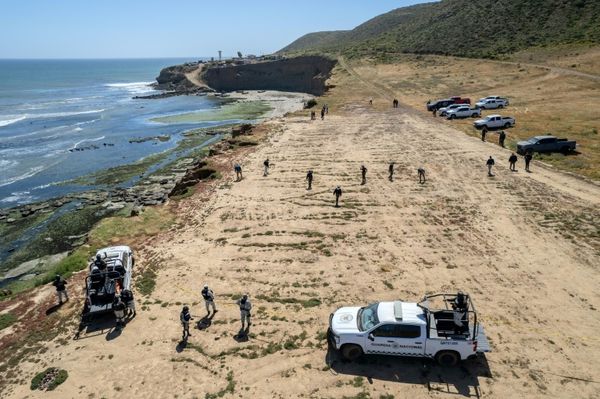
Year 7 students at a private school in Mparntwe (Alice Springs) wrote letters to the Northern Territory Environment Minister Lauren Moss protesting against a proposed water allocation plan. Less than six weeks later, two representatives from her department came to the school to ensure students had both sides of the story.
“Dear Minister Moss, have you ever lived in the outback where, for want of a more descriptive word, it is dry,” one student’s letter begins.
The 37 letters (condensed into email format) from the St Philip’s College students were sent to Moss on May 21. They document concerns about the NT government’s 2022-23 iteration of the Western Davenport Water Allocation Plan, which controls 24,500 sq km of groundwater use for an area south of Tennant Creek. This region includes the site of the nation’s biggest water licence — Singleton Station — which is set to be transformed into an international farming project.
The students join the long list of environmental groups, Traditional Owners and even the government’s appointed committee who’ve called for the plan to be scrapped.
“Where is the water going? Overseas. For drinking water? No, for agricultural purposes. It is an atrocious waste of water and what has the government done? Absolutely nothing. Surely you can open your eyes to see this greed-riddled scheme,” one letter reads.
“What really ticks me off is that only 30% of the water extracted is staying in Australia,” another student writes. “I feel offended that not even half stays in Australia.”
Some students put their names to the letters, others signed off as “Year 7 student”, and one wrote on behalf of “me and all students of my school”. The letter template, however, was a brief introduction followed by a recognition of water — particularly groundwater — as a precious resource in the desert; a commitment to listen to First Nations peoples when it comes to protecting, preserving and using water; a line or two about how the proposed plan was at odds with this; and finally a request for the minister to withdraw it. Several students stuck to the suggested script, but many threw in their knowledge and colour to let the NT government know they meant business.
“It has come to the concern of me and my colleagues,” begins one student. “I’m 13 but that’s beside the point,” writes another. A third student: “If this does reach you, please don’t make me settle for some kind of prewritten message.”
On top of the written content, there are also drawings of angry trees, staged diagrams of death captioned “dying because of the plan”, before-and-after pictures of happy plants turned sad, and visual equations of tree plus animal equals dead.

St Philip’s College principal Leslie Tilbrook tells Crikey that after the letters were emailed as a PDF package to Moss, she was visited by the regional director of the NT Environment Department, John Gaynor. She says he came with a printed package of the letters and asked for the opportunity to present the government’s perspective to students.
“He said I really feel strongly that they were only given one side of this issue and I would like the opportunity to address them,” Tilbrook says, adding that from an educational standpoint this was an ideal response because it gave students two sides of a story and therefore an opportunity to think for themselves.
“We have to train students to be critical thinkers, to be able to understand bias and critically interrogate issues. I want these kids to question where they get their information from because a lot of it comes from unreliable resources.”
On June 21, Gaynor and executive director of water resources Amy Dysart came to the school and presented a 29-page PowerPoint pack to the entire cohort of Year 7 students and a few teachers.
A spokesperson for the Environment, Parks and Water Security Department tells Crikey that it’s always “willing and available to provide science-backed presentations” for schools engaging with environmental content to provide balance and help students make “informed judgments”.
Crikey understands the presentation was not open to the public and teachers were not permitted to take notes.
The department later shared a copy of the presentation with Crikey, which includes entry-level explanations of the water cycle through to complex maps on things such as groundwater-dependent ecosystem probability and thresholds of acceptable change.
Some of the maps are pulled from the previous 2021-22 water allocation plan, rather than the 2022-23 draft plan that the students’ letters related to.

Central Land Council CEO Les Turner says the content shown to students by the department was misleading.
Turner previously accused the NT government of providing deceptive and out-of-date information to Indigenous stakeholders during “pretend consultations” on the proposed plan. He says that although the PowerPoint presentation differs from what Traditional Owners were shown, the messaging is consistent: “They are both misleading.”
The student PowerPoint states that the total water available is “equivalent to 272 Sydney Harbours”, with extraction to be capped at 6% of the overall volume: “94% of water remains in the ground.”
Alex Vaughan, policy officer at the Arid Lands Environment Centre, says the focus on volume is deceptive because it fails to account for water depth. In short, it’s shallow, not deep like Sydney Harbour. Vaughan tells Crikey that means any minor change to depth catastrophically impacts the surrounding environment: damage to 100 kilometres of groundwater-dependent trees, soaks and wetlands, all of which carry enormous ecological and cultural value.
Feedback from the classroom was that the government answered a lot of questions, but didn’t actually answer any. As the students were keen to point out in their letters, they wanted the government to see through their age and legitimately hear them.
“I may be young, and many may not take me seriously, but my generation will inherit this world and all mistakes with it,” one student wrote.
“If you’re just going to exclude the kids from water we might as well be living on Mars but we are the aliens,” said another.
“Every other year when you take 80 billion litres, [it] cuts kids’ lives shorter and it’s not one by one, it’s all together, all the lives of kids, adults, Elders. Which are leftovers to the scraps of your money which can [buy] cars and building farms, but can’t buy the future,” they wrote, signing the letter with an Arrernte stamp.
“P.S. This is my country.”







